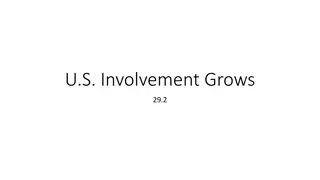Essential Insights on the Vietnam War: Causes, Effects, and Public Opinion Split
Delve into the significant aspects of the Vietnam War, including the reasons for U.S. intervention, challenges faced by U.S. troops against the Viet Cong, public opinion polarization, and the tumultuous year of 1968 marked by pivotal events. Explore the complexities and repercussions of one of the most controversial conflicts in history.
Download Presentation

Please find below an Image/Link to download the presentation.
The content on the website is provided AS IS for your information and personal use only. It may not be sold, licensed, or shared on other websites without obtaining consent from the author.If you encounter any issues during the download, it is possible that the publisher has removed the file from their server.
You are allowed to download the files provided on this website for personal or commercial use, subject to the condition that they are used lawfully. All files are the property of their respective owners.
The content on the website is provided AS IS for your information and personal use only. It may not be sold, licensed, or shared on other websites without obtaining consent from the author.
E N D
Presentation Transcript
Americans, p. 728-765 Ch. 22: The Vietnam War Years History Alive! P. 654-693 Ch. 51: The United States Gets Involved in Vietnam Ch. 52: Facing Frustration in Vietnam Ch. 53: Getting Out of Vietnam Top Essentials to Know About the Vietnam War By Martin Kelly http://americanhistory.about.com/od/vietnam/tp/vietnam-war.htm Vietnam 101: A Short Introduction By Kennedy Hickman http://militaryhistory.about.com/od/vietnamwar/p/VietnamBrief.htm
Chapter 22 The Vietnam War Years 1. Why did the U.S. enter the war in Vietnam? The U.S. entered the war in Vietnam to try to support the government of the South because it did not want communists in the North to control the whole country. -containment; Eisenhower support Diem (opposed Ho); USS Maddox/Gulf of Tonkin incident (Resolution) Additional details/answers? Americans, p. 728-765
Chapter 22 The Vietnam War Years 2. Why could the U.S. not win a quick victory over the Viet Cong, and what was the effect? The U.S. could not quickly defeat the Vietcong because they engaged in guerrilla tactics of quick attacks and disappearing into the jungle. The result was a loss of morale among U.S. soldiers. -political limitations were placed on superior US weapons & numbers (military was not effective ); enemy was difficult to identify; napalm (incendiary/explosive); agent orange (defoliant); civil war (self-determination) QUAGMIRE! -Additional details/answers? Americans, p. 728-765
Chapter 22 The Vietnam War Years 3. How did public opinion split over the war? As the war continued and victory seemed less achievable, American society split into hawks, who favored the war, and doves, who opposed it. They were bitterly opposed to each other, and some hawks thought that antiwar protesters were disloyal. - draft dodgers fled to Canada or burned draft cards; returning vets greeted harshly (spit on); Additional details/answers? Americans, p. 728-765
Chapter 22 The Vietnam War Years 4. Why is 1968 considered a year of upheaval? The year 1968 was marked by loss of confidence and violence: a major North Vietnamese offensive* weakened American support for fighting the war. Also, President Johnson decided not to seek re-election, two major leaders (MLK and Robert Kennedy) were killed, and violence marred the Democratic convention. -*Tet Offensive; presidential advisors questioned the war; Nixon elected president Additional details/answers? Americans, p. 728-765
Chapter 22 The Vietnam War Years 5. What were the effects of the war? As a result of the war in Vietnam, many American soldiers were dead (58,000+) or wounded (158- 303,000+), and many more scarred by their reception when they returned home. The war created deep divisions in American society and opened mistrust of people toward the government. -Tet Offensive (lied about success? ); changed US foreign policy (Congressional limits on troop commitments); Pentagon Papers Additional details/answers? Americans, p. 728-765
Ch. 51 - The United States Gets Involved in Vietnam After World War II, nationalist and communist rebels in the French colony of Vietnam fought for their independence. A 1954 agreement ending this colonial war split the country into communist North Vietnam and democratic South Vietnam. When France pulled out the following year, the United States stepped in to prop up South Vietnam. Over the years, American involvement grew and eventually led to the introduction of U.S. ground forces. First Indochina War In this first phase of fighting, which lasted from 1946 to 1954, Ho Chi Minh led Viet Minh insurgents in the struggle to end French rule in Vietnam. Geneva Accords The First Indochina War ended with a 1954 agreement known as the Geneva Accords. The accords split Vietnam into north and south but called for elections to reunify the country. The United States backed South Vietnam financially and militarily. Viet Cong Insurgents in the south, known as the Viet Cong, worked to overthrow the nominally democratic but corrupt government of South Vietnam. The Viet Cong received aid from communist North Vietnam. Gulf of Tonkin Resolution An alleged attack on U.S. ships off the coast of North Vietnam led Congress to pass the Gulf of Tonkin Resolution. This resolution gave President Johnson broad powers to expand the U.S. role in Vietnam. Massive air strikes against North Vietnam followed. Ho Chi Minh Trail By 1965, North Vietnamese Army troops were moving south along the Ho Chi Minh Trail to help the Viet Cong. The United States feared that South Vietnam would fall without more direct support. Americanization In March 1965, the United States began sending ground troops to fight the Vietnam War. The war quickly became an American conflict.
Ch. 52 - Facing Frustration in Vietnam The United States decided to wage a limited war in Vietnam, with limited troop strength. Fighting an elusive enemy on unfamiliar terrain frustrated U.S. soldiers. The South Vietnamese people themselves were unsure whom to support: the Saigon government or the communist- backed Viet Cong. As the war dragged on, American antiwar protests grew. Opposition to the war greatly affected the 1968 elections. War of attrition The U.S. military waged a war of attrition, hoping to wear down the enemy by inflicting heavy losses. Increasing the enemy body count became a key military goal. Opposing Vietnamese armies Regular troops of the North Vietnamese Army (NVA) joined forces with Viet Cong insurgents. The United States trained the Army of the Republic of Vietnam (ARVN) to defend South Vietnam. New weapons of war The United States sprayed the herbicide Agent Orange to clear forest vegetation and expose the enemy. It dropped napalm firebombs that burned forests and buildings and caused widespread destruction. Both weapons had devastating effects on the Vietnamese population. Credibility gap The Johnson administration s optimistic public assessments of the war did not match reality. This created a credibility gap, and many Americans lost faith in the president. Protest movement Antiwar protesters on college campuses and elsewhere held demonstrations and carried out acts of civil disobedience. The protesters called for peace negotiations and an end to the war. Tet Offensive Some 45,000 Viet Cong and NVA soldiers died after launching a major offensive in 1968. But the Tet Offensive also boosted U.S. opposition to the war and undermined the Johnson presidency, helping to pave the way for Richard Nixon s election in 1968.
Ch. 53 - Getting Out of Vietnam In 1969, President Nixon began withdrawing U.S. troops from Vietnam, but the war continued throughout his time in office. He carried on peace talks with the North Vietnamese but also ordered massive bombing of North Vietnam, Cambodia, and Laos. He faced ongoing protests from the antiwar movement and criticism from Congress. In 1973, the last U.S. combat forces came home. North Vietnam swept to victory over the South in 1975. Vietnamization Nixon s Vietnamization of the war allowed for the withdrawal of U.S. troops and prepared South Vietnam to take over responsibility for the war. My Lai massacre In 1968, U.S. soldiers slaughtered hundreds of Vietnamese civilians in the village of My Lai. Reports of the massacre shocked Americans and increased antiwar protests. Kent State shootings The invasion of Cambodia in April 1970 sparked an increase in antiwar protests. The most violent one occurred the following month at Kent State University in Ohio, where National Guard troops fired into an angry crowd, killing four students. War Powers Resolution Congress reacted to Nixon s activities in Cambodia by passing the War Powers Resolution. This resolution limits a president s ability to send armed forces into combat. Pentagon Papers In 1971, Daniel Ellsberg leaked to the press a top-secret study of the U.S. role in Indochina. This study, the Pentagon Papers, revealed secrecy and deceit on the part of U.S. presidents. Boat people The North Vietnamese defeated South Vietnam and took control in 1975. This prompted an exodus of refugees from Indochina, many of whom fled by boat.























